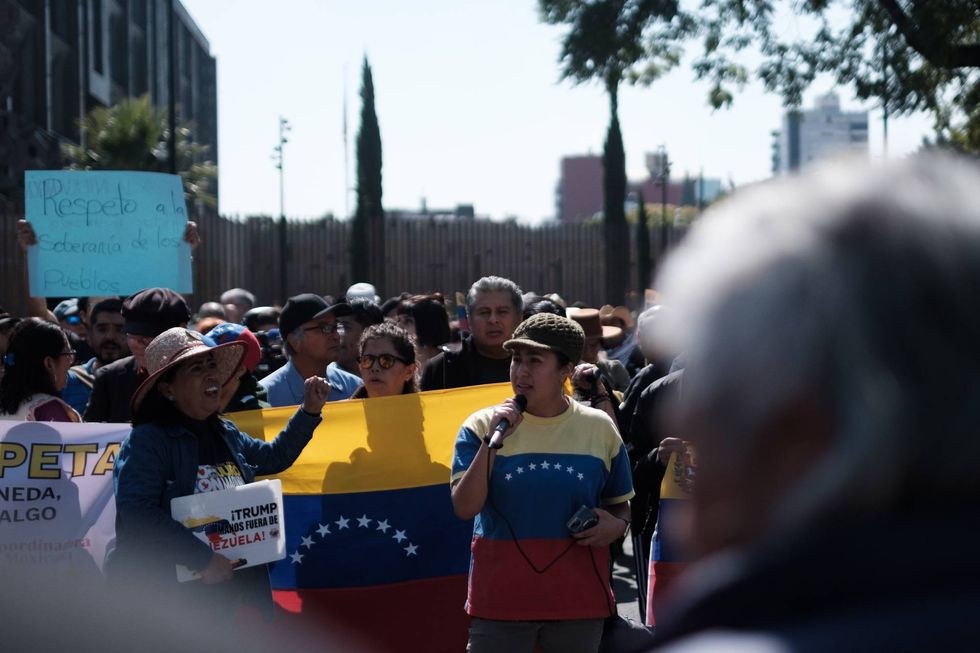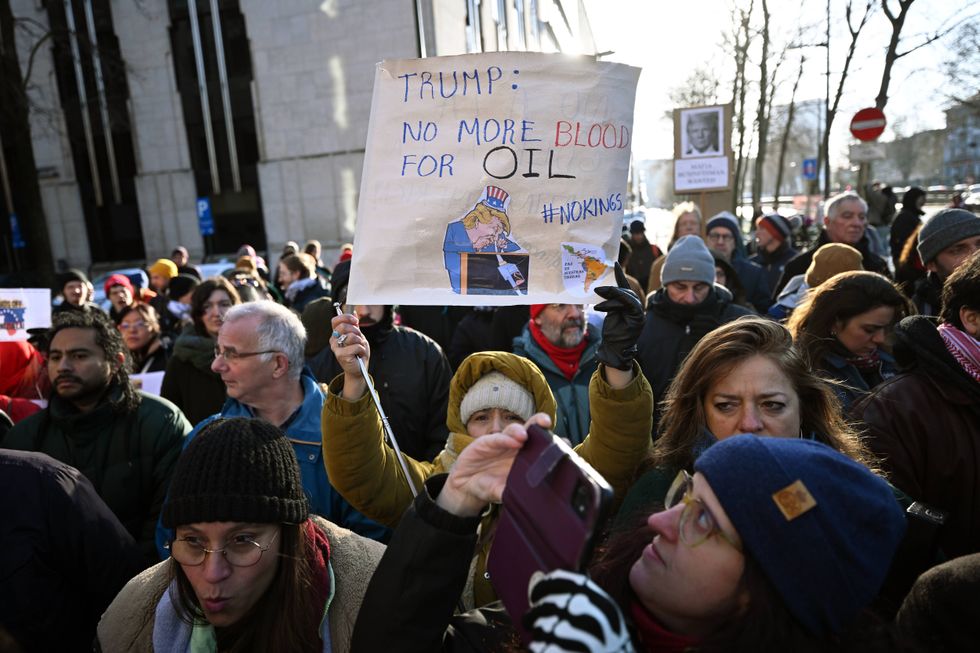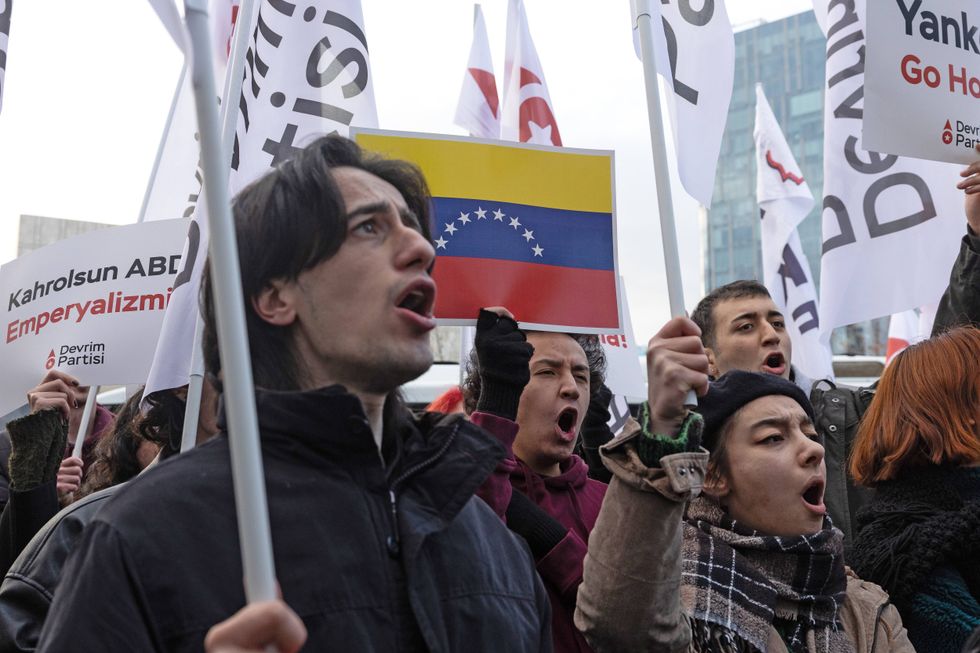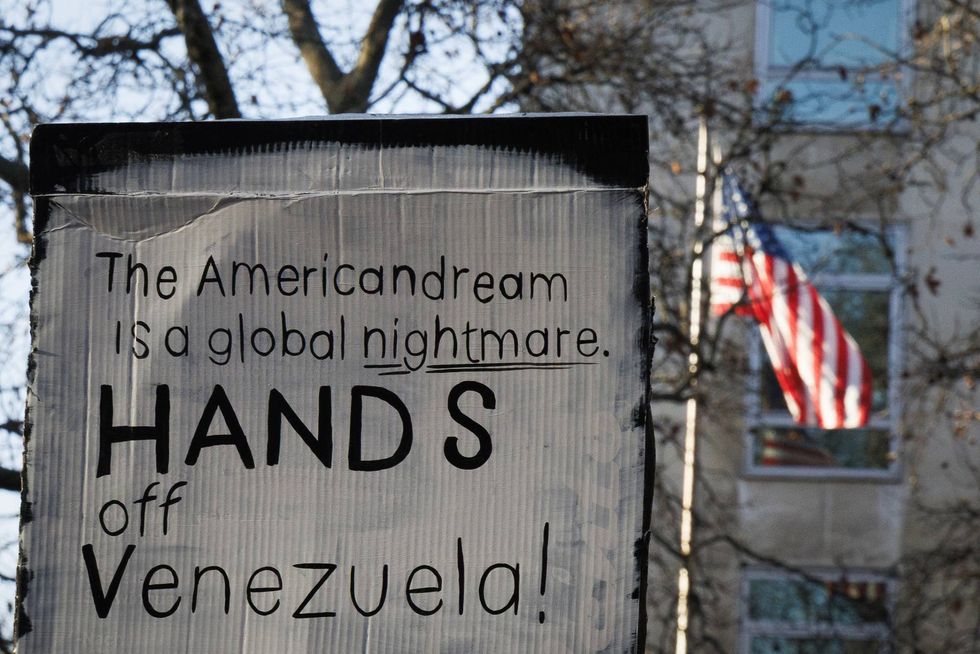

SUBSCRIBE TO OUR FREE NEWSLETTER
Daily news & progressive opinion—funded by the people, not the corporations—delivered straight to your inbox.
5
#000000
#FFFFFF
To donate by check, phone, or other method, see our More Ways to Give page.


Daily news & progressive opinion—funded by the people, not the corporations—delivered straight to your inbox.
Allegra Harpootlian
ReThink Media
(303) 748 - 4051
From 2018 to 2020, the United States government undertook what it labeled "counterterrorism" activities in 85 countries.
From 2018 to 2020, the United States government undertook what it labeled "counterterrorism" activities in 85 countries. According to new data released today by the Costs of War Project and published in a map by USA Today, these activities ranged from direct combat to training foreign forces.
The map illustrates countries in which the U.S. government conducted operations it explicitly described as counterterrorism, in an outgrowth of President George W. Bush's "Global War on Terror." These operations include air and drone strikes, on-the-ground combat, so-called "Section 127e" programs in which U.S. special operations forces plan and control partner force missions, military exercises in preparation for or as part of counterterrorism missions, and operations to train and assist foreign forces. (The map does not comprehensively cover the full scope of U.S. post-9/11 warfare, as it does not document, for instance, U.S. military bases used for counterterror operations, arms sales to foreign governments, or all deployments of U.S. special operations forces.)
Despite the Pentagon's assertion that the U.S. is shifting its strategic emphasis away from counterterrorism and towards great power competition with Russia and China, examining U.S. military activity on a country-by-country basis shows that there is yet to be a corresponding drawdown of the counterterror apparatus. If anything, the map demonstrates that counterterrorism operations have become more widespread in recent years.
Stephanie Savell, co-director of the Costs of War Project and lead researcher for this resource, says, "At a time when many Americans are calling for an end to endless wars, this map raises important questions: why is the United States undertaking militaristic operations in so many countries, and are these activities actually functioning to protect Americans and other civilians around the world? The U.S. public and its leaders must first recognize the true scope of the post-9/11 wars in order to end them."
This map is the latest resource from the Costs of War project, housed at Brown University's Watson Institute and Boston University's Pardee Center. The project was launched by a group of scholars and experts to document the unacknowledged costs of the post-9/11 wars in Afghanistan, Iraq, and elsewhere.
"This is militarized authoritarianism," said one advocacy group. "We must act to stop it now, before it spreads to enflame the entire region, if not the entire globe, in a dangerous, unnecessary conflict."
Protests broke out at US diplomatic outposts across the globe Saturday and Sunday following the Trump administration's deadly attack on Venezuela and abduction of the nation's president, brazen violations of international law that—according to the American president—were just the start of a sustained intervention in Venezuela's politics and oil industry.
Demonstrators took to the streets of Brussels, Madrid, Ankara, Mexico City, Los Angeles, and other major cities worldwide to voice opposition to the US assault on Venezuela and Trump administration officials' pledge to "run" the country's government for an unspecified period of time, a plan that Venezuelan leaders have publicly met with defiance.
The US Mission to Mexico—one of several Latin American countries Trump threatened in the aftermath of the attack on Venezuela—warned in an alert issued Saturday that "a protest denouncing US actions against Venezuela continues to take place in front of the US Embassy in the Polanco neighborhood of Mexico City."
"Protestors have thrown rocks and painted vandalism on exterior walls," the alert read. "Social media posts about the protest have included anti-American sentiment. Embassy personnel have been advised to avoid the area."





The global demonstrations came as some world leaders, including top European officials, faced backlash for failing to adequately condemn—or condemn at all—the US attack on Venezuela and continued menacing of a sovereign nation.
Ursula von der Leyen, president of the European Commission, said she supports "a peaceful and democratic transition," without mentioning or denouncing the illegal abduction of Venezuelan President Nicolás Maduro and US bombings that reportedly killed at least 40 people, including civilians.
Greek Prime Minister Kyriakos Mitsotakis declared that "this is not the time to comment on the legality of the recent actions" as protesters gathered in Athens in opposition to the US assault.
"If you still believe that the European Union cares about international law, then look no further," wrote Progressive International co-general coordinator David Adler, pointing to Mitsotakis' statement.
"We are outraged, but this moment demands more than outrage. It demands organized, coordinated resistance."
Mass protests and demands for international action to halt US aggression proliferated amid ongoing questions about how the Trump administration intends to carry out its stated plan to control Venezuela and exploit its oil reserves—objectives that experts say would run afoul of domestic and international law.
US Secretary of State Marco Rubio, who played a central role in planning the Venezuela attack and has been chosen by Trump to manage the aftermath, said Sunday that the administration intends to keep in place a military "quarantine" around the South American nation—including the massive naval force amassed in the Caribbean in recent months—to pressure the country's leadership to bow to US demands.
"That's a tremendous amount of leverage that will continue to be in place until we see changes, not just to further the national interest of the United States, which is number one, but also that lead to a better future for the people of Venezuela," Rubio said in a television interview.
Rubio also suggested the president could deploy US troops to Venezuela and dodged questions about the legal authority the Trump administration has to intervene in the country. The administration has not sought congressional authorization for any of its attacks on vessels in the Caribbean or Venezuela directly.
US Rep. Greg Casar (D-Texas), chair of the Congressional Progressive Caucus, said Sunday that "in recent history, we've tried 'running' multiple countries in Latin America and the Middle East. It's been a disaster for us, and for them, every single time."
"Congress must pass a War Powers Resolution to get our military back to defending the US, instead of 'running' Venezuela," Casar added.
Progressive Democrats of America echoed that demand, saying in a statement that "this is militarized authoritarianism."
"We must act to stop it now, before it spreads to enflame the entire region, if not the entire globe, in a dangerous, unnecessary conflict," the group added. "We are outraged, but this moment demands more than outrage. It demands organized, coordinated resistance."
"They have spoken openly about controlling Venezuela’s oil reserves, the largest in the world," said US Sen. Bernie Sanders. "It recalls the darkest chapters of US interventions in Latin America."
US President Donald Trump left no doubt on Saturday that a—or perhaps the—primary driver of his decision to illegally attack Venezuela, abduct its president, and pledge to indefinitely run its government was his desire to control and exploit the country's oil reserves, which are believed to be the largest in the world.
Over the course of Trump's lengthy press conference following Saturday's assault, the word "oil" was mentioned dozens of times as the president vowed to unleash powerful fossil fuel giants on the South American nation and begin "taking a tremendous amount of wealth out of the ground"—with a healthy cut of it going to the US "in the form of reimbursement" for the supposed "damages caused us" by Venezuela.
"We're going to have our very large United States oil companies, the biggest anywhere in the world, go in, spend billions of dollars, fix the badly broken infrastructure, and start making money for the country," Trump said, suggesting American troops could be deployed, without congressional authorization, to bolster such efforts.
"We're going to get the oil flowing the way it should be," he added.
Currently, Chevron is the only US-based oil giant operating in Venezuela, whose oil industry and broader economy have been badly hampered by US sanctions. In a statement on Saturday, a Chevron spokesperson said the company is "prepared to work constructively with the US government during this period, leveraging our experience and presence to strengthen US energy security."
Other oil behemoths, some of which helped bankroll Trump's presidential campaign, are likely licking their chops—even if they've been mostly quiet in the wake of the US attack, which was widely condemned as unlawful and potentially catastrophic for the region. Amnesty International said Saturday that "the stated US intention to run Venezuela and control its oil resources" likely "constitutes a violation of international law."
"The most powerful multinational fossil fuel corporations stand to benefit from these aggressions, and US oil and gas companies are poised to exploit the chaos."
Thomas O'Donnell, an energy and geopolitical strategist, told Reuters that "the company that probably will be very interested in going back [to Venezuela] is Conoco," noting that an international arbitration tribunal has ordered Caracas to pay the company around $10 billion for alleged "unlawful expropriation" of oil investments.
The Houston Chronicle reported that "Exxon, America’s largest oil company, which has for years grown its presence in South America, would be among the most likely US oil companies to tap Venezuela’s deep oil reserves. The company, along with fellow Houston giant ConocoPhillips, had a number of failed contract attempts with Venezuela under Maduro and former President Hugo Chavez."
Elizabeth Bast, executive director of the advocacy group Oil Change International, said in a statement Saturday that the Trump administration's escalation in Venezuela "follows a historic playbook: undermine leftist governments, create instability, and clear the path for extractive companies to profit."
"The most powerful multinational fossil fuel corporations stand to benefit from these aggressions, and US oil and gas companies are poised to exploit the chaos and carve up one of the world's most oil-rich territories," said Bast. "The US must stop treating Latin America as a resource colony. The Venezuelan people, not US oil executives, must shape their country’s future."
US Sen. Chris Van Hollen (D-Md.) said that the president's own words make plain that his attack on Venezuela and attempt to impose his will there are "about trying to grab Venezuela's oil for Trump's billionaire buddies."
In a statement, US Sen. Bernie Sanders (I-Vt.) echoed that sentiment, calling Trump's assault on Venezuela "rank imperialism."
"They have spoken openly about controlling Venezuela’s oil reserves, the largest in the world," said Sanders. "It recalls the darkest chapters of US interventions in Latin America, which have left a terrible legacy. It will and should be condemned by the democratic world."
“What is being done to Venezuela is barbaric," said Delcy Rodríguez, who assumed the role of interim president following the US abduction of Nicolás Maduro.
Venezuelan Vice President Delcy Rodríguez, who assumed the role of interim president following the US abduction of Nicolás Maduro, said in a televised address Saturday that "we will never again be a colony of any empire," defying the Trump administration's plan to indefinitely control Venezuela's government and exploit its vast oil reserves.
“We are determined to be free,” declared Rodríguez, who demanded that the US release Maduro from custody and said he is still Venezuela's president.
“What is being done to Venezuela is barbaric," she added.
Rodríguez's defiant remarks came after US President Donald Trump claimed he is "designating various people" to run Venezuela's government, suggested American troops could be deployed, and threatened a "second wave" of attacks on the country if its political officials don't bow to the Trump administration's demands.
Trump also threatened "all political and military figures in Venezuela," warning that "what happened to Maduro can happen to them." Maduro is currently detained in Brooklyn and facing fresh US charges.
Rodríguez's public remarks contradicted the US president's claim that she privately pledged compliance with the Trump administration's attempts to control Venezuela's political system and oil infrastructure. The interim president delivered her remarks alongside top Venezuelan officials, including legislative and judicial leaders, Interior Minister Diosdado Cabello, and Defense Minister Vladimir Padrino, a projection of unity in the face of US aggression.
"Doesn’t feel like a nation that is ready to let Donald Trump and Marco Rubio 'run it,'" said US Sen. Chris Murphy (D-Conn.), who condemned the Trump administration for "starting an illegal war with Venezuela that Americans didn’t ask for and has nothing to do with our security."